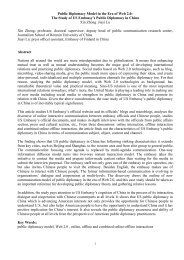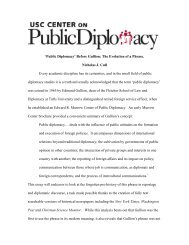Buddhist Diplomacy: History And Status Quo. - USC Center on ...
Buddhist Diplomacy: History And Status Quo. - USC Center on ...
Buddhist Diplomacy: History And Status Quo. - USC Center on ...
- No tags were found...
You also want an ePaper? Increase the reach of your titles
YUMPU automatically turns print PDFs into web optimized ePapers that Google loves.
BUDDHIST DIPLOMACY: HISTORY AND STATUS QUO 19became important learning centers and propagati<strong>on</strong> instituti<strong>on</strong>s ofBuddhism. As Buddhism became increasingly influential, someof the m<strong>on</strong>asteries developed into large-scale m<strong>on</strong>astic-universitycomplexes that attracted students from different parts of the world.For example, during the Pala Empire (750–1174 CE) some statefundedm<strong>on</strong>asteries in East India attracted m<strong>on</strong>ks, scholars, andstudents from such diverse locati<strong>on</strong>s as China, Tibet, Sri Lanka,Nepal, Korea, Greece, and Persia. It also attracted d<strong>on</strong>ati<strong>on</strong>s fromforeign kings. 70 These m<strong>on</strong>astic universities taught different schoolsof <str<strong>on</strong>g>Buddhist</str<strong>on</strong>g> thought and other disciplines such as medicine, andtrained missi<strong>on</strong>aries in the skills of transmitting Buddhism. 71 They arec<strong>on</strong>sidered am<strong>on</strong>g the earliest universities in the world. The largest<strong>on</strong>es included Nalanda, Odantapuri and Vikramasila. Historiansrecorded that Odantapuri permanently housed a thousand m<strong>on</strong>ks andsometimes “twelve thousand m<strong>on</strong>ks c<strong>on</strong>gregated there”. 72 ChineseM<strong>on</strong>k Xuan Zang recorded that the Nalanda University had morethan 1,500 teachers to look after and guide 10,000 students. 73 Thesem<strong>on</strong>asteries c<strong>on</strong>tinued to train m<strong>on</strong>ks until they were destroyed byinvading Muslim troops in the 12th century.6. Influence of opini<strong>on</strong> leaders.The history of Buddhism’s transmissi<strong>on</strong> shows that opini<strong>on</strong>leaders in a society were usually the first influenced by the new faith.When kings, queens, princes, princesses, literati and artists became<str<strong>on</strong>g>Buddhist</str<strong>on</strong>g> followers, other members of society would more likely toaccept the new faith. This is particularly true in the ancient timeswhen a foreign idea could be easily perceived as a heresy and threatto the traditi<strong>on</strong>al beliefs. For example, when Buddhism was firstintroduced to China and Tibet, it was initially resisted by aboriginalfaiths. With the effort of leaders in the societies, it went through aprocess of localizati<strong>on</strong> and was eventually accepted.7. Translati<strong>on</strong> of <str<strong>on</strong>g>Buddhist</str<strong>on</strong>g> texts and gifting in diplomacyPerhaps the most important means of <str<strong>on</strong>g>Buddhist</str<strong>on</strong>g> transmissi<strong>on</strong>across borders is the translati<strong>on</strong> of <str<strong>on</strong>g>Buddhist</str<strong>on</strong>g> texts as the faith enteredinto different countries and cultures. The Buddha’s teachings were











